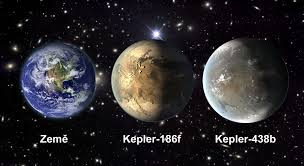
The starry sky is now far more fascinating to us than it ever was to our forebears. Stars may seem just points of light, but we’ve learnt recently that most are orbited by retinues of planets, just as our Sun is. Our galaxy probably harbours many billions of planets.
The most fascinating question of all is how many might harbour life — even intelligent life? Could Kepler 438b be part of the answer?
Kepler 438b is a very Earth-like planet whose discovery was announced this week. There’s special interest in “twins” of our Earth - planets the same size as ours, orbiting other Sun-like stars.
475 light years away
Kepler 438b is one of those. It’s 475 light years away, and it’s on an orbit in the “Goldilocks zone” — not so close to its star that water boils away, nor so far that it’s perpetually icy.
It was discovered by the small telescope on board Nasa’s Kepler spacecraft, which monitored the brightness of 150,000 stars for more than three years.
Some stars underwent slight regular dimmings, caused by orbiting planets that transit in front of them, blocking out a bit of their light.
The Kepler data has already revealed many surprises. Our solar system may be far from typical. In some systems, planets as big as Jupiter are circling so close to their star that their “year” lasts only a few days.
Some planets orbit binary stars — there would be two “Suns” in their sky. But we’d really like to see these planets directly — not just their “silhouettes” as they pass in front of their parent star. And that’s hard.
To realise just how hard, suppose an alien astronomer with a powerful telescope was viewing the Earth from 30 light years away — the distance of a nearby star.
It would seem, in Carl Sagan’s phrase, a “pale blue dot”, very close to a star (our Sun) that far outshines it: a firefly next to a searchlight.
But if the aliens could detect Earth, they could learn quite a lot about it. The shade of blue would be slightly different, depending on whether the Pacific Ocean or the Eurasian land mass was facing them.
They could infer the length of our day, the seasons, that there are continents and oceans, and the climate.
By analysing the faint light, they could infer that the Earth had a biosphere. We don’t yet have telescopes powerful enough to make such observations of planets beyond our solar system.
But before 2030, the unimaginatively named ELT (“Extremely Large Telescope”) planned by European astronomers will offer the combination of light-gathering power and sharpness of imaging to draw such inferences about those planets orbiting nearby, Sun-like stars. The ELT will have a mirror 39 metres across (actually a mosaic of 800 sheets of glass).
A mountaintop in Chile has been levelled to provide the optimum site; construction will soon begin. But should we expect life on these distant worlds? It’s the uncertain biology that’s the main stumbling block.
Searching for evidence
We know how simple life evolved into our present biosphere. But we don’t know how the first life was generated from a “soup” of chemicals. It might have involved a fluke so rare that it happened only once in the entire galaxy — like shuffling a whole pack of cards into a perfect order.
On the other hand, this crucial transition might have been almost inevitable given the “right” environment. The stakes are so high that it’s surely worth searching for evidence of advanced alien life, though we may not be able to recognise it.
For some alien “brains” may package reality in a fashion that we can’t conceive of, and have a quite different perception of reality. Others could be uncommunicative: living contemplative lives, perhaps deep under some planetary ocean.
The most durable form of “life” may be machines whose creators had long ago been usurped or become extinct. There may be a lot more out there than we could ever detect. Absence of evidence wouldn’t be evidence of absence. Perhaps we’ll one day “plug in” to a galactic community.
On the other hand, Earth’s intricate biosphere may be unique. But that would not render life a cosmic sideshow. Interstellar travel in our lifetimes isn’t realistic (the magic tricks used in the movie Interstellar are, sadly, science fiction). But humans aren’t the culmination of evolution.
Our solar system is barely middle aged and if we humans avoid self-destruction, the “post-human” era beckons. Prolonged interstellar travel wouldn’t be a challenge to near-immortal “post-humans”.
Alternatively, small spacecraft could carry genetic material, or “blueprints”, via laser transmission (“space travel” at the speed of light). And these could trigger the assembly of living organisms in propitious locations.
Life seeded from Earth could spread through the entire galaxy, evolving into a teeming complexity far beyond what we can conceive. If so, our tiny planet — this pale blue dot floating in space — could be the most important place in the entire cosmos.
— The Telegraph Group Limited, London 2015
Lord Martin Rees is the Astronomer Royal.











